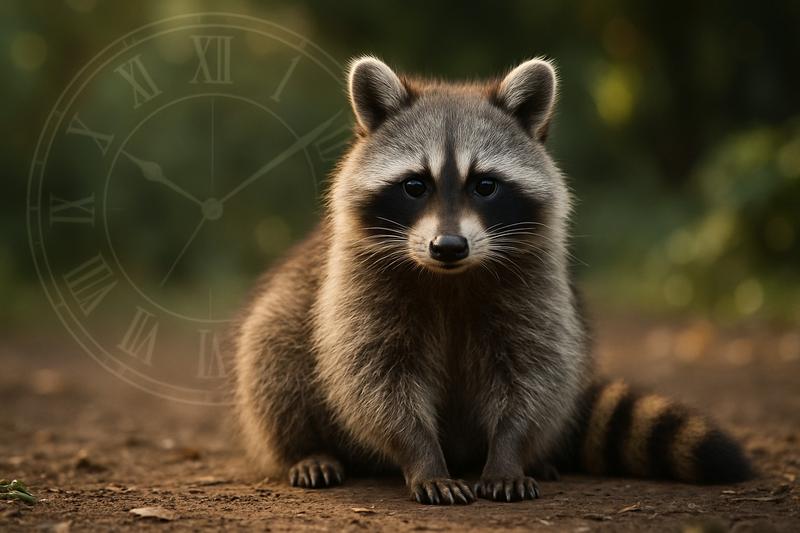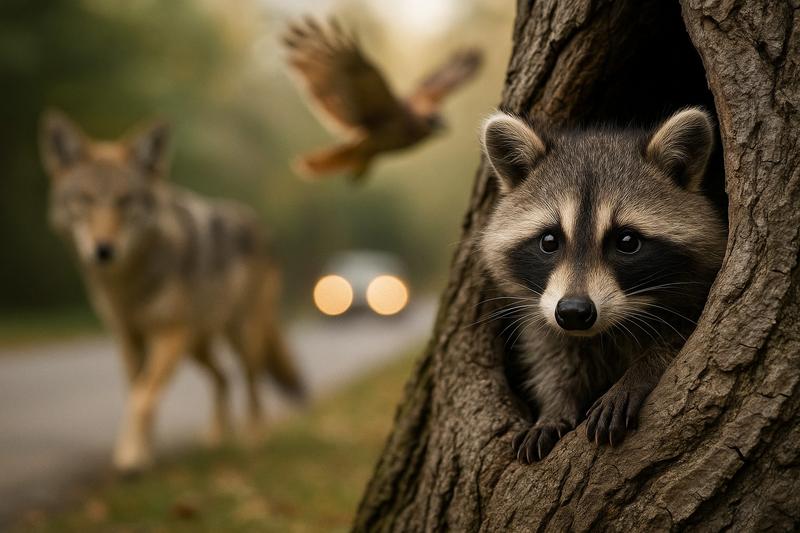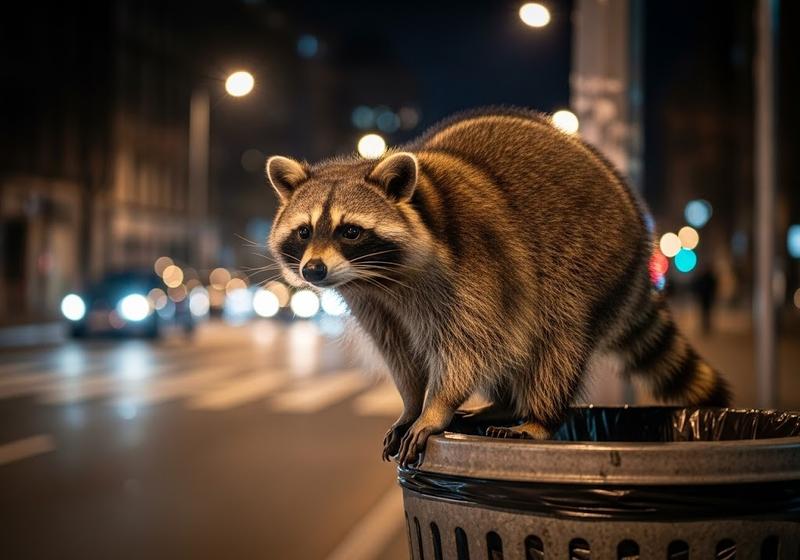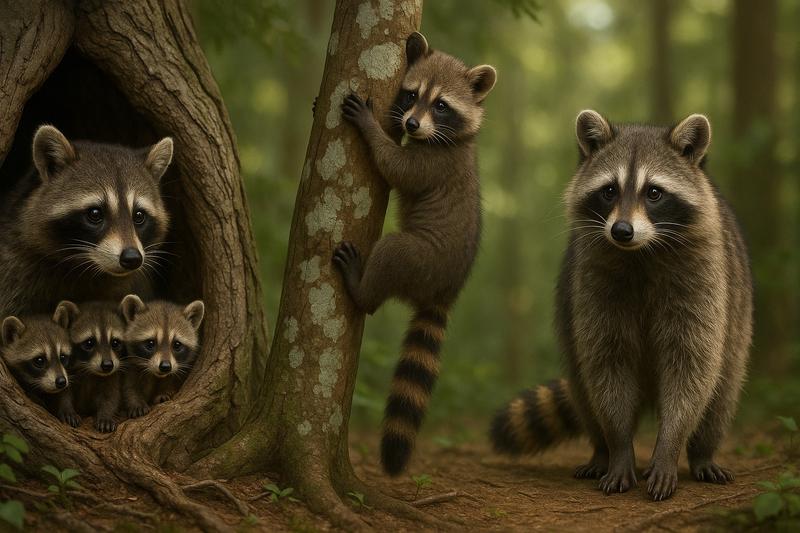How Long Do Raccoons Live? Wild vs Captive Lifespans Explained

Raccoons typically live 2–3 years in the wild but can survive up to 20 years in captivity. Their lifespan varies drastically depending on where they live, the threats they face, and whether they have access to medical care and steady food. In this post, we’ll explore what shortens or extends a raccoon’s life and how they compare to other animals in their ecosystem.
Wild vs Captivity - What’s the average lifespan of a raccoon?
The question of how long raccoons live doesn’t have a single answer—it depends entirely on their environment. A raccoon in the forest doesn’t live the same life as one lounging near a suburban trash bin or one under veterinary care in a wildlife sanctuary.
How long do raccoons live in the wild?
In the wild, most raccoons live 1.8 to 3.1 years, with a small percentage making it to 5 or 6 years. The first year is the hardest—more than half of all baby raccoons, called kits, won’t survive beyond 12 months. Those that do make it past the early risks still face predators, disease, accidents, and food scarcity.
Raccoons in rural areas tend to live shorter lives than their urban counterparts due to more exposure to predators and less access to consistent food sources.
How long do raccoons live in captivity?
In contrast, captive raccoons—those raised in zoos, wildlife rehabilitation centers, or as legal exotic pets—can live 15 to 20+ years. Without natural predators, with access to regular food and veterinary care, raccoons can reach old age. One raccoon in captivity was documented to live nearly 21 years, a rare milestone for this adaptable mammal.
What shortens a raccoon’s life in the wild?
Life in the wild can be harsh for raccoons, especially during their early months. Several factors contribute to their shortened lifespan:
Predators and natural threats
Raccoons are opportunistic scavengers but also prey animals. Their natural predators include:
-
Coyotes and wolves in rural areas
-
Bobcats and mountain lions in forested regions
-
Large birds of prey, like owls and eagles, especially targeting young kits
-
Snakes, which may invade dens for eggs or kits
These threats often come suddenly and leave little room for escape, especially when kits are still learning survival skills.
Disease and health risks
Raccoons are vulnerable to several deadly diseases, which often spread quickly in wild populations:
-
Rabies, a major concern for humans and pets
-
Canine distemper, which mimics rabies symptoms and is highly contagious
-
Baylisascaris procyonis (raccoon roundworm), a parasitic infection
Diseases can not only reduce raccoon populations but also lead to human intervention—often through euthanasia or relocation.
Human-related dangers
Raccoons are frequent victims of human infrastructure and activity:
-
Roadkill: A leading cause of death for raccoons in both urban and suburban areas
-
Traps and poisons used by homeowners
-
Habitat destruction from new development
-
Starvation and malnutrition, as a raccoon's survival in lean times directly depends on how long it can live without food and water.
Ironically, human food sources may help raccoons live longer—but human actions also contribute significantly to their deaths.
While these health risks are real, it's important to remember the many beneficial roles raccoons play in the ecosystem.

Raccoons face numerous threats in the wild, from predators like coyotes and hawks to road accidents near human areas.
How raccoons adapt to urban life (but still face risks)
Raccoons are often seen as the clever city-dwellers of the animal kingdom, and for good reason. They’ve adapted to survive in places few wild animals can.
Do city raccoons live longer?
Yes and no. Urban raccoons often enjoy:
-
Abundant food (garbage, pet food, compost)
Fewer natural predators -
Shelter under decks, attics, garages
These benefits can lead to longer lives—some urban raccoons have been documented to live 6–8 years, especially in areas with animal control support and low road traffic.
Urban dangers for raccoons
However, city life brings its own set of challenges:
-
Increased car accidents in traffic-heavy areas
-
Dependency on humans that reduces survival skills
-
Trapping or euthanasia in response to nuisance behavior
-
Chemical exposure through pesticides or antifreeze spills
Despite these threats, many urban raccoons live longer than their rural cousins simply due to consistent food and reduced predation.

Urban raccoons thrive on abundant food and shelter in cities but face risks like traffic and human conflict.
Raccoon life cycle: From kits to adults
To understand raccoon lifespan, it’s helpful to look at the life cycle stages.
How long do baby raccoons (kits) survive?
Raccoon kits are typically born in spring. A litter can have 2–5 kits, and they stay in the den with their mother for about 8–10 weeks. The mortality rate is high—only 30–50% make it to adulthood. Causes of death include:
-
Abandonment
-
Predation
-
Disease
-
Drowning or exposure
Survival depends heavily on the mother’s health, den location, and weather conditions.
How long do adult raccoons live?
If a raccoon survives its first year, its chances of living 4–5 years improve significantly. Adult raccoons reproduce once per year, with breeding seasons peaking in late winter to early spring. Once mature, they live solitary lives, occasionally grouping only during mating or mothering phases.

The raccoon life cycle: from vulnerable kits in their den to curious juveniles and fully grown adults ready to survive on their own.
Raccoon lifespan vs other animals: Who lives longer?
Let’s compare raccoon longevity with some of their common wild counterparts:
|
Animal |
Wild Lifespan |
Captive Lifespan |
|
Raccoon |
2–5 years |
15–20 years |
|
Opossum (North America's only marsupial) |
1–2 years |
3–4 years |
|
Fox |
3–6 years |
10–14 years |
|
Skunk |
2–3 years |
7–10 years |
Raccoons tend to live longer than opossums but usually shorter than foxes in the wild. However, their captive lifespan rivals or surpasses most of these animals due to their adaptability and intelligence.
FAQ: More Questions About Raccoon Lifespan
Do male and female raccoons live the same amount of time?
Yes, although both sexes have similar average lifespans, female raccoons may face added risks during breeding season and while caring for young, which can slightly reduce their survival rates in the wild.
How long do raccoons live during winter?
Winter is one of the most dangerous seasons for raccoons—especially young kits. Adults may survive several winters, but cold weather, food scarcity, and frozen dens significantly shorten life expectancy for the weak or young.
What kills most raccoons in cities?
In urban areas, vehicle collisions and rodenticide poisoning are major causes of death. Raccoons in cities often have easier access to food but face high human-related hazards.
Can raccoons survive more than 10 years in the wild?
It's rare. In the wild, only a very small percentage of raccoons make it past 10 years due to predators, accidents, and disease. The average is closer to 2–3 years.
Do raccoons hibernate in cold climates?
No, raccoons do not hibernate. Instead, they enter a state of torpor—a semi-dormant condition where they rest in dens for long periods but may still emerge during warmer spells.
What’s the average lifespan of a raccoon in the wild vs captivity?
-
Wild: 2–3 years (due to external threats)
-
Captivity: 15–20 years (with veterinary care, no predators)
Are baby raccoons more likely to die in the first year?
Yes. The first year is the most dangerous. High infant mortality is due to predators, abandonment, harsh weather, and difficulty finding food after weaning.
Do raccoons die naturally of old age?
Very rarely in the wild. Most raccoons succumb to external threats long before natural aging becomes a factor. Natural death is more likely in captivity.
What affects how long raccoons live - and what we can learn
Despite their cleverness and adaptability, raccoons face immense challenges in the wild. Their average wild lifespan of 2–3 years is a sobering reminder of how harsh nature can be. But when given protection and care, they can live up to 20 years, showing just how resilient these creatures are.
If you’re curious about the lives of wild animals in your backyard—or want to know how to coexist with them—understanding lifespan is just the beginning. The raccoon is not just a masked scavenger; it's a survivor, navigating a world that’s changing fast.
This survivor spirit is exactly what makes them so captivating. If you share this appreciation for their resilience, why not show it off? Celebrate the clever, tough, and charming nature of these animals with our Raccoon Aesthetic Outfit collection or find a design that captures their playful side in our gallery of funny animal shirts.
Recent Posts
- How Long Can Raccoons Survive Without Food or Water?
- Are Raccoons Marsupials? Here's the Truth Behind the Confusion
- Are Raccoons Related to Bears? The Evolutionary Truth Explained
- Is a Raccoon a Rodent? The Truth About Their Classification
- 15 Animals That Look Like Raccoons and What Makes Them So Similar
- What Are Raccoons Good For? 4 Surprising Benefits You Should Know
- What’s a Group of Raccoons Called? Fun Facts & Rare Terms
- 20 Fun Facts About Raccoons That'll Surprise You
- Return Policy for Clothing Online: What You Need to Know
- How to Check the Quality of a T-Shirt Before Buying (2025 Guide)

